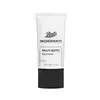What's inside
What's inside
 Key Ingredients
Key Ingredients

 Benefits
Benefits

 Concerns
Concerns

 Ingredients Side-by-side
Ingredients Side-by-side

Water
Skin ConditioningNiacinamide
SmoothingGlycerin
HumectantAlpha-Glucan Oligosaccharide
CleansingParaffinum Liquidum
EmollientCetearyl Alcohol
EmollientPalmitic Acid
EmollientInulin
Skin ConditioningPetrolatum
EmollientStearic Acid
CleansingPolymnia Sonchifolia Root Juice
Skin ConditioningPhenoxyethanol
PreservativeButyrospermum Parkii Butter
Skin ConditioningGlyceryl Stearate
EmollientMaltodextrin
AbsorbentPEG-100 Stearate
Carbomer
Emulsion StabilisingAllantoin
Skin ConditioningSodium Acrylate/Sodium Acryloyldimethyl Taurate Copolymer
Emulsion StabilisingIsohexadecane
EmollientTocopheryl Acetate
AntioxidantEthylhexylglycerin
Skin ConditioningDimethicone
EmollientAlpha-Arbutin
AntioxidantSodium Hydroxide
BufferingXanthan Gum
EmulsifyingO-Cymen-5-Ol
AntimicrobialPolysorbate 80
EmulsifyingLactobacillus
Skin ConditioningSorbitan Oleate
EmulsifyingSimmondsia Chinensis Seed Oil
EmollientSodium Hyaluronate
HumectantPanthenol
Skin ConditioningButylene Glycol
HumectantDenatonium Benzoate
MaskingPortulaca Oleracea Extract
Skin ConditioningWater, Niacinamide, Glycerin, Alpha-Glucan Oligosaccharide, Paraffinum Liquidum, Cetearyl Alcohol, Palmitic Acid, Inulin, Petrolatum, Stearic Acid, Polymnia Sonchifolia Root Juice, Phenoxyethanol, Butyrospermum Parkii Butter, Glyceryl Stearate, Maltodextrin, PEG-100 Stearate, Carbomer, Allantoin, Sodium Acrylate/Sodium Acryloyldimethyl Taurate Copolymer, Isohexadecane, Tocopheryl Acetate, Ethylhexylglycerin, Dimethicone, Alpha-Arbutin, Sodium Hydroxide, Xanthan Gum, O-Cymen-5-Ol, Polysorbate 80, Lactobacillus, Sorbitan Oleate, Simmondsia Chinensis Seed Oil, Sodium Hyaluronate, Panthenol, Butylene Glycol, Denatonium Benzoate, Portulaca Oleracea Extract
Water
Skin ConditioningPropanediol
SolventNeopentyl Glycol Diheptanoate
EmollientButyrospermum Parkii Butter
Skin ConditioningCetearyl Alcohol
Emollient1,2-Hexanediol
Skin ConditioningMacadamia Ternifolia Seed Oil
EmollientCetearyl Olivate
Sorbitan Olivate
EmulsifyingGlyceryl Stearate
EmollientCetyl Ethylhexanoate
EmollientCarbomer
Emulsion StabilisingTromethamine
BufferingButylene Glycol
HumectantTocopheryl Acetate
AntioxidantSodium Hyaluronate
HumectantEthylhexylglycerin
Skin ConditioningTrisodium Ethylenediamine Disuccinate
Camellia Sinensis Leaf Water
MaskingWater, Propanediol, Neopentyl Glycol Diheptanoate, Butyrospermum Parkii Butter, Cetearyl Alcohol, 1,2-Hexanediol, Macadamia Ternifolia Seed Oil, Cetearyl Olivate, Sorbitan Olivate, Glyceryl Stearate, Cetyl Ethylhexanoate, Carbomer, Tromethamine, Butylene Glycol, Tocopheryl Acetate, Sodium Hyaluronate, Ethylhexylglycerin, Trisodium Ethylenediamine Disuccinate, Camellia Sinensis Leaf Water
 Reviews
Reviews

Ingredients Explained
These ingredients are found in both products.
Ingredients higher up in an ingredient list are typically present in a larger amount.
Butylene Glycol (or BG) is used within cosmetic products for a few different reasons:
Overall, Butylene Glycol is a safe and well-rounded ingredient that works well with other ingredients.
Though this ingredient works well with most skin types, some people with sensitive skin may experience a reaction such as allergic rashes, closed comedones, or itchiness.
Learn more about Butylene GlycolThis ingredient is also known as shea butter. It is an effective skin hydrator and emollient.
Emollients help soothe and soften your skin. It does this by creating a protective film on your skin. This barrier helps trap moisture and keeps your skin hydrated. Emollients may be effective at treating dry or itchy skin.
Shea butter is rich in antioxidants. Antioxidants help fight free-radicals, or molecules that may harm the body. It is also full of fatty acids including stearic acid and linoleic acid. These acids help replenish the skin and keep skin moisturized.
While Shea Butter has an SPF rating of about 3-4, it is not a sunscreen replacement.
Shea butter may not be fungal acne safe. We recommend speaking with a professional if you have any concerns.
Learn more about Butyrospermum Parkii ButterCarbomer is a polymer of acrylic acid. Its main role is to create a gel consistency.
A high amount of carbomer can cause pilling or balling up of products. Don't worry, most products contain 1% or less of carbomer.
Cetearyl alcohol is a mixture of two fatty alcohols: cetyl alcohol and stearyl alcohol. It is mainly used as an emulsifier. Emulsifiers help prevent the separation of oils and products. Due to its composition, it can also be used to thicken a product or help create foam.
Cetearyl alcohol is an emollient. Emollients help soothe and hydrate the skin by trapping moisture.
Studies show Cetearyl alcohol is non-toxic and non-irritating. The FDA allows products labeled "alcohol-free" to have fatty alcohols.
This ingredient is usually derived from plant oils such as palm, vegetable, or coconut oils. There is debate on whether this ingredient will cause acne.
Due to the fatty acid base, this ingredient may not be Malassezia folliculitis safe.
Learn more about Cetearyl AlcoholEthylhexylglycerin (we can't pronounce this either) is commonly used as a preservative and skin softener. It is derived from glyceryl.
You might see Ethylhexylglycerin often paired with other preservatives such as phenoxyethanol. Ethylhexylglycerin has been found to increase the effectiveness of these other preservatives.
Glyceryl Stearate is a mix of glycerin and stearic acid.
It is used to stabilize the mixing of water and oil ingredients. By preventing these ingredients from separating, it can help elongate shelf life. It can also help thicken the product's texture.
As an emollient, it helps soften skin and supports barrier-replenishing ingredients.
In cosmetics, Glyceryl Stearate is often made from vegetable oils or synthetically produced.
This ingredient may not be fungal-acne safe
Fun fact: The human body also creates Glyceryl Stearate naturally.
Learn more about Glyceryl StearateSodium Hyaluronate is hyaluronic acid's salt form. It is commonly derived from the sodium salt of hyaluronic acid.
Like hyaluronic acid, it is great at holding water and acts as a humectant. This makes it a great skin hydrating ingredient.
Sodium Hyaluronate is naturally occurring in our bodies and is mostly found in eye fluid and joints.
These are some other common types of Hyaluronic Acid:
Learn more about Sodium HyaluronateTocopheryl Acetate is AKA Vitamin E. It is an antioxidant and protects your skin from free radicals. Free radicals damage the skin by breaking down collagen.
One study found using Tocopheryl Acetate with Vitamin C decreased the number of sunburned cells.
Tocopheryl Acetate is commonly found in both skincare and dietary supplements.
Learn more about Tocopheryl AcetateWater. It's the most common cosmetic ingredient of all. You'll usually see it at the top of ingredient lists, meaning that it makes up the largest part of the product.
So why is it so popular? Water most often acts as a solvent - this means that it helps dissolve other ingredients into the formulation.
You'll also recognize water as that liquid we all need to stay alive. If you see this, drink a glass of water. Stay hydrated!
Learn more about Water